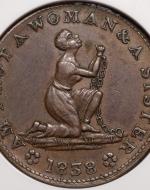Created by Katrina Furr on Thu, 03/31/2022 - 01:48
Description:
The ‘Am I Not a Man and a Brother’ image was a crucial image in the abolishment of slavery and the slave trade. Created by Josiah Wedgewood, it had a large impact in pushing back against slavery and creating a face for the abolishion movement. Later another image was created titled ‘Am I not a woman and a sister?’ The female version was circulated around the 1830s although the artist is unknown.
The ‘Am I not a woman and a sister?’ image is very similar to the ‘Am I not a man and a brother with a black slave kneeling on one knee. The slave is chained but is raising their arms as if begging. The ‘Am I not a woman and a sister?’ became very popular in the 1900s when a group of women in Britain were fighting for the end of slavery and the right to have a voice in political conversations. During the time period, women were not allowed to be included in politics of any kind. This means that they could not participate in the abolitionist movement and could not even sign any petitions fighting to end slavery. Women, of course, still wanted to participate in some way and so they wrote literature in the form of poems and used certain images to encourage women's rights.
One of the women who was very important in both women getting noticed as well as the abolition movement was Elizabeth Heyrick. Heyrick was a huge supporter of abolition and was very influential in what she was doing during the 1820s. Her main idea was that abolition needed to be more immediate and was often known to call out other people asking for an end to slavery because they weren’t asking to end it fast enough. She would eventually write a pamphlet called “Immediate not Gradual Abolition” that called for an immediate end to slavery in the British colonies. Women were really attracted to the idea and gave Heyrick’s campaign a lot of support. The Americas would eventually recognize her work later when they were trying to abolish slavery there. In an article talking about slavery abolishment in the americas it says, “British women were already playing an influential role in the antislavery movement. One of them, Elizabeth Heyrick, had suggested as early as 1824 that the reformers’ goal should be ‘immediate, not gradual abolition’ –a phrase which provided the slogan for radical abolitionism in America. Several female antislavery societies were organized in Great Britain during the 1820s” (Brown 2).
In April of 1825, Lucy Townsend who was a friend of Elizabeth Heyrick, had a meeting which would allow women to come together and talk about the rights that they should have in the anti-slavery movement. At this meeting, the Birmingham Ladies Society for the Relief of Negro Slaves was established. This society was different from the Anti-Slavery Society and had more of a focus on women in the movement. The women made a huge push for the boycotting of sugar in protest which was very important to the anti slavery movement. On the University of Birmingham website it says, “Independent Women’s Groups were formed across the country – the Women’s Group in Leicester was personally started by Elizabeth Heyrick. By 1831, there were seventy-three of these groups pushing for the abolition of slavery, and the work of these women was integral to the national conversation on the topic of abolition” (Enright 6). Clearly this womens group was a big deal and was very much needed at the time period, not only to help slaves, but to help women find their voice.
Another important aspect of the Birmingham Ladies Society is their use of the image ‘Am I not a woman and a sister?’ This society used the image on their own medal similar to how the Anti-Slavery Society used ‘Am I not a man and a brother?’ Although the images are very similar, to the women it not only meant all that the male version did, but had the added meaning that comes along with the female kneeling. This really pushed for the start of feminism and womens rights which would come a couple decades later.
Sources:
Brown, Ira V. “‘AM I NOT A WOMAN AND A SISTER?’ THE ANTI-SLAVERY CONVENTION OF AMERICAN WOMEN, 1837–1839.” Pennsylvania History: A Journal of Mid-Atlantic Studies, vol. 50, no. 1, Penn State University Press, 1983, pp. 1–19, http://www.jstor.org/stable/27772873.
Enright, Mairead. “Gender and Legal History in Birmingham and the West Midlands.” University of Birmingham, 2018.


